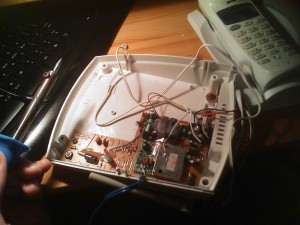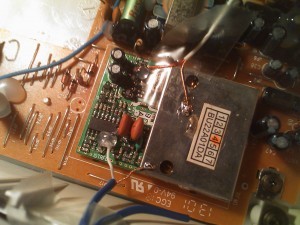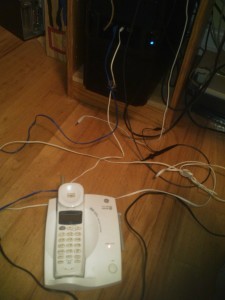Cordless Phone Hack – Interfacing with a PC
For a long time I’ve wanted to be able to interface a cordless phone with my computer. I often do voice calls using Skype and G-Mail, and of course sometimes I’d like to be able to leave my desk. Wireless headsets are of course available, I’ve even purchased a Bluetooth headset, but the range of Bluetooth, and the quality, leave a lot to be desired. However, cordless phones not only have decent sound quality, they also have great range. I had an old GE phone in a box that I hadn’t used in about 2 and a half years, so I took it out and set to work.
There are two ways to practically interface my computer to the phone. The cleanest solution is to make a device that allows me to convert the audio input/output to/from the computer to a telephone line signal. I did some research (ie, Googled), and didn’t find enough information to help me (not that it doesn’t exist, I just didn’t find it). There are many commercial options, but most of them are designed to work with particular software (ie, just Skype) whereas I wanted more flexibility. I opted then for the dirtier route: audio injection.
The idea behind this is simple: open up the base, find where the audio signal pins are on the RF (radio frequency) module, and connect wires to those pins that allow me to connect my computer to it (headphone jacks). In order to find these pins, I went through the following process:
Initial Setup (Disclaimer)
Before we go too far: I am not responsible for anything that results from your decision to follow this write-up, including but not limited to property damage, fire, injury, or death.
Here are some risks of damage:
- Damage to the phone
- Damage to your computer (if you send 12V into your microphone port because you connected the wrong pin…)
- Damage to anything you plug into the phone to test (measurement equipment, used responsibly should be fine, but I meant mp3 players and such.)
Having said that, here are some important considerations:
- Do not perform any work on your device while it is connected to the telephone line! (You may not only slightly injure yourself, but the voltage can be high enough to be dangerous, cause fire, or suspend your phone service.)
- Exercise general caution when probing: some components get hot, (I found that out), and ensure you never cross two pins when probing (I didn’t find that out): you may end up with a brick if you do that.
- Do not solder any connections while the device is plugged in. Unplug the base before soldering any wires.
My setup for probing was simply that: the DC adapter plugged into the wall, and nothing more.
Finding the Phone’s Microphone
This step may have been the more difficult of the two, but I was lucky: the board had a single IC on it: KA8532. After reading through the datasheet (PDF download) for this chip, I discovered that the audio output is on pin 14. This made probing with my oscilloscope a lot easier. I pressed Talk on the phone, and put my probe on that pin: silence. Then I spoke, and saw my voice on the oscilloscope display: can it really be so simple?
Finding the Phone’s Speaker
I say that this was easier because I took the brute force method. I grabbed an old mp3 player I didn’t care about being damaged, stripped the ends of some headphone cable, hit play and simply touched different pins on the interfacing connector between the main PCB and the RF module, and waited to hear music on the phone. Once I did, I knew that was the right pin!
Make the Connection
I scrounged through my wire bucket and found two headphone cables: one for the microphone and one for the speaker. I soldered the wires in place to the pins I discovered.
At this point, I connected the two cables to the computer, and hit Talk. The phone tried… and failed to connect. I was confused, but only slightly. I disconnected the base from the computer and tried again: it now worked. I believe that I may have connected my speaker wire to a pin that also controlled something to do with the RF communications. By plugging it in before the connection is established, it may create noise that makes connection impossible. So to make a call, first I hit Talk, then I plug it to the computer.
Extra Features
At this point, the dialing buttons don’t work. The phone wont ring when I get a call, and there is no caller ID. The sound quality is better than my Bluetooth, the range is great, but there is a little bit of noise (not bad considering I’m not using any filtering of any kind.) But I don’t care. It does exactly what I set out for it to do. This morning I tested it with a call lasting over 2 hours, and no disconnections, no errors. Amazingly, the battery in the phone is about 8 years old, if not more, and hasn’t been charged in over 2.5 years… Success!




very cool – great idea!
Great project. Found it while trying to cook up my own. I need a phone jack near my fax but do not want to run wires. Phone over powerline stinks. I thought I could hack a wireless phone to achieve it, but not sure where to begin. Any help greatly appreciated.
Basic idea is this:
Phone line connects to base of wireless phone (i.e. my Panasonic KX-TG6511B which has great range and reception). Then I crack open the handset [this is where your help comes in!] and soldier the proper two or four wires to a telephone phone jack. Then run telephone cable to fax.
Issues:
How to initiate a call? Or maybe not an issue if I manually put phone off hook and then press send on fax machine.
How to receive an incoming fax. Would the fax “hear” the incoming call as the wireless handset rings?
Power to the handset! I guess I’d have to occasionally set the handset in the base to charge. On this issue, the good news is that I rarely send or receive faxes so I could probably get away with leaving it uncharged for days or longer.
Anyone wanna try to figure this out with me, or more specifically, tell me if you know if it is worth me cracking open a perfectly functional phone handset?
My technique deals with two low-voltage audio signals: in and out, receive and transmit. It was never intended to be used with the analog telephone network.
Telephone lines are not simple in/out lines. They operate in a loop, where both input and output signals exist on the same line. Telephone lines operate at -48VDC, which is much higher than the low-voltage audio signals found in a cordless phone. Because of these fundamental differences, you could not simply solder some wires inside the phone to serve as a telephone line.
However! You could possibly, depending on how your fax machine was designed, take apart your fax machine and locate its corresponding low level audio signal wires. It would then be a matter of connecting the TX line of one device to the RX line of the other.
There are of course numourous other issues that may arise (the phone may have some noise filtering, gain control, echo cancellation, etc). The sound quality was not exceptional from what I obtained. Voices were a bit muffled, although a conversation could still be held.
This is the only semi-feasible construction I can imagine using a cordless phone for this purpose. The fax would not be able to receive, because the internal circuitry relies on the 90VDC signal sent from the telephone company. You would need to dig further inside in order to find where that signal gets interpreted, and spoof the ringing signal. The cordless phone may have a light that illuminates when ringing, which could be the trigger you need.
This is a helpful tip (poke around on the chip) for what I’m trying to do, which is simply convert an old cordless phone into a wireless microphone. The range should be great, and I’m not sure how good the sound quality will be, but I picked up this phone for $5 at a used goods store, so it’s worth a try. It’s at times like this I wish I still had my ‘scope. Thanks!
Thanks for sharing this.
I am very much interested in hacking electronics stuff. I have 2 phonesets from different vendors and trying to figure out a way to make all of them use the same line. Any pointers any of you can share would be appreciable.
Thanks in advance,
VC
I want to purchase this phone
Haha, I don’t think there’s much use for this anymore with Bluetooth around!